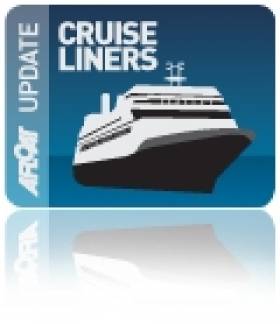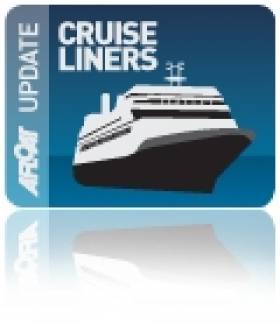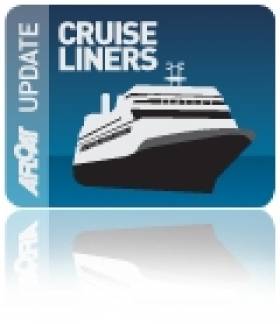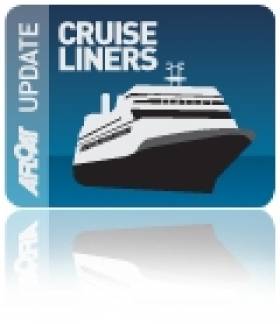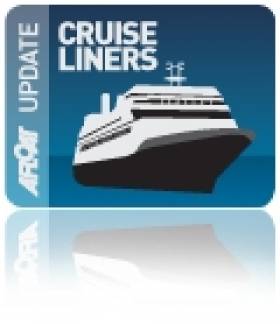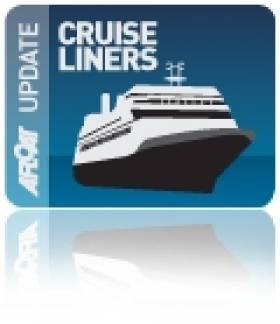Displaying items by tag: Queen Elizabeth
Woman Dies Boarding Queen Elizabeth Cruise Liner
#CruiseLiners - Telegraph Travel reports that a passenger on the Queen Elizabeth has died after an incident while boarding the ocean liner as it was anchored off Cambodia.
The female passenger, who has not been named, was boarding the Cunard cruise ship from a tender off Sihanoukville in Cambodia's south-west when she ended up in the water.
Despite the tender's crew quick efforts to rescue her from the water, she later died in the ship's medical centre.
The newest addition to Cunard's cruise liner fleet, and the second largest after the Queen Mary 2, was last seen in these waters when she berthed off Dun Laoghaire in August 2013.
The Telegraph has much more on the story HERE.
Queen Elizabeth Cruise Liner: Celebrating the Luxury of Art Deco
#QueenElizabeth – Queen Elizabeth's maiden visit off Dun Laoghaire Harbour today presented a wonderful sight, not to mention her impressive and sumptuous art-deco style interiors which pay homage to the legendary 1930's Cunard Ocean Liner RMS Queen Elizabeth, writes Jehan Ashmore.
The 'Vista' class 90,901 tonnes cruiseship, is the newest of the Cunard Line fleet and she was commissioned in 2010 and named by Queen Elizabeth II in Southampton. A portrait of the monarch by Isobel Peachey hangs in the splendid foyer of the Grand Lobby.
Captain C. Wells has command of the vessel with 2,040 guests which is close to her capacity of 2,100 passengers and almost 1,000 crew members. On the cruise of British and Irish ports which set off from Southampton at the end of July, the majority of the guests are from the UK and United States in addition to around 150 Germans who boarded in Hamburg.
Her guests can expect high standards with the history and pedigree of Cunard Line and among the features on Queen Elizabeth are the Grand Lobby with its magnificent mural of her 1930's predecessor. There are eight restaurants, two theatres, three swimming pools and a games deck, together with a large spa and fitness centre, shopping arcade, libraries, bars, cafés, and a casino.
The library with 7,000 books is the second largest floating library in the world after Queen Mary 2 and there's also an art gallery with paintings by Irish artist Philip Gray. In addition to those who fancy a cigar one can decline to the intimate wood-panelled surroundings of Churchill's Lounge sited high above the seas.
The Queen's Room Photo: Jehan Ashmore

The Grand Lobby Photo: Jehan Ashmore
In essence the cruiseship exudes luxury that respects the golden day era of liners whilst also combining the many wonderful modern day comforts to which cruise-goers also demand.
Queen Elizabeth is due to weigh anchor 21.00hrs this evening and after a day spent at sea her next port of call is St. Peter Port, Guernsey before her return to Southampton
Another ‘Cunarder’ Call is to Bring 'Elizabeth'
#CunarderCALL – Cunard Line's newest cruiseship, the 90,901 tonnes Queen Elizabeth is to make her maiden call off Dun Laoghaire Harbour tomorrow. She is the second largest ship built for the company after Queen Mary 2 which called earlier this summer, writes Jehan Ashmore.
Queen Elizabeth has 12 passenger decks accommodating 2,068 guests and the 294m vessel first paid a visit to Dublin Bay with a call to Dublin Port in 2011, the same year of her namesake's historic state visit by Queen Elizabeth. A subsequent return call by the cruiseship as previously reported was made this time last year.
Captain C. Wells has command of the 2010 built ship which is currently docked alongside Liverpool Cruise Terminal and is due to arrive in Dublin Bay around 07.30hrs tomorrow morning.
Her visit to Dun Laoghaire is part of a British Isles 12-Day Cruise which set off from Hamburg late last month and terminates in Southampton following an en route call to St. Peter Port, Guernsey.
Cunard Line's third ship, Queen Victoria is a sister and they both are of the same design to P&O Cruises Arcadia which called offshore to Dun Laoghaire almost a month ago. There are external differences particularly along the uppermost decks.
Both companies are subsidiaries of the world's largest cruise shipping group, Carnival Corporation which too operates Holland America Line (HAL) whose medium-sized cruiseship, Eurodam recently visted Dublin Port and as previously reported off Dunmore East.
Eurodam also shares this same Italian built cruiseship design, from the Fincantieri shipyard in Marghera, Venice, albeit the most notable difference is the twin funnel stacks.
Additonal information from Dun Laoghaire Harbour Company:
The prestigious Queen Elizabeth cruise liner will dock in Dún Laoghaire Harbour tomorrow, Wednesday, 7th August 2013, from 7am to 6pm.
The ship belongs to the world-famous Cunard Line and is decorated in an art deco style reminiscent of 1930s ocean liners. Dún Laoghaire will be the fifth port of call for the Queen Elizabeth since it set sail from Southampton a week ago on a 10-day cruise of Britain and Ireland.
Speaking ahead of the arrival, CEO of Dún Laoghaire Harbour Company, Gerry Dunne, said: "The iconic Queen Mary 2 visited Dún Laoghaire in May and today we are delighted to welcome her sister ship, the Queen Elizabeth. It is a tremendous boost for the harbour to have a visit from a ship of her calibre."
Ports & Shipping Review: ‘Signature’ Cruiseship, Fishery Detentions, ‘Royal’ Cruiseship, Belfast’s Battleship, Port of Cork Wins Award
#PORTS & SHIPPING REVIEW - Over the last fortnight Jehan Ashmore has reported from the Shipping scene which saw 'signature' cruiseship Mein Schiff 2 with her striking visual livery-scheme calling to Irish ports.
The Naval Service has been made detentions of Irish registered fishing vessels this week and also last month off the Clare and Cork coastlines, bringing to date 12 such incidents so far this year.
The world's smallest 5-star luxury cruiseship Hebridean Princess (1964/2,112grt) which was chartered twice in recent years for the Royal Family, called to Dublin Port recently and is currently on a return cruise from Cork with anchorage calls in Kerry waters.
Dublin Based d'Amico have ordered a pair of 40,000dwt eco-product/chemical tanker vessels, believed to cost US$ 30.65 million, from a South Korean shipyard and delivered early in 2014.
Since her launch in 2010, Cunard Line's newest cruiseship Queen Elizabeth (90,901 tonnes) made her second only visit to Dublin Port, where she called last year and also to Cork, which too was revisited by the 2068 passenger vessel.
The on-going saga to retain the veteran WWI Battle of Jutland survivor HMS Caroline in Belfast, her homeport since 1924 was given a reprieve. The National Museum of the Royal Navy (NMRN) in Portsmouth secured a four-week extension to the original deadline (1 Aug) which was set for scrapping of the historic warship.
The near fifty year-old Hebble Sand (1963/757grt), a grab-hopper dredger which has remained in Dublin Port for more than one year departed Dublin Port and reached Campbeltown last week for new Northern Irish owners Abco Marine.
Port of Cork Company was awarded 'Large Company of the Year for the 2nd Quarter 2012' by the Cork Business Association. This season the port is to welcome 60 cruiseships between April and November, bringing more than 100,000 passengers and crew to the region.
While in Dublin Port, Finnish based Kristina Cruises 400 passenger Kristina Katarena made her inaugural Irish call, the 1982 built vessel was launched from New Szczecin Shipyard. The name of the Polish city may sound familiar as they are the presenting sponsor of Tall Ships Races which are coming to the capital later this month.
Cunard Line's Newest Cruiseship to Revisit
#CUNARDER REVISIT – Since her launch in 2010, Cunard Line's newest cruiseship the 90,901 tonnes Queen Elizabeth has only called to Dublin Port once and that was last year. She was then on her maiden 'Irish' port of call and the 2068 passenger vessel is to return on Saturday, writes Jehan Ashmore.

Joining her on the schedule of visiting cruiseships this August, which not surprisingly is the busiest period of the high-season, will be Holland America Line's Maasdam. She is to arrive only an hour later that morning.
The month is scheduled to see 28 cruise callers (list) in total, the first caller having already arrived yesterday with the Hebridean Princess staying overnight in the port.
Following the Cunarder's call she will her head overnight bound for Cobh Cruise Terminal, where the Italian built vessel also made an inaugural port of call (list) in 2011.
Cruising By Royal Appointment
#CRUISELINERS- She may be one of the smallest cruiseships operating, however Hebridean Princess (1964/2,112grt) which is to call to Dublin Port this evening, is big in terms of her status, writes Jehan Ashmore.
A plaque was unveiled on board in May to recognise that the ship has been granted a Royal Warrant by Queen Elizabeth II, as the Royal Family chartered the 5-star luxury vessel in Scottish waters in 2006 and 2010.
The warrant for the provision of cruise holidays came into effect at the start of this year and her owners Hebridean Island Cruises will be the only travel brand honoured in such a way.
The interiors are modelled on those of a large country mansion, where each of 30 cabin suites are individually decorated in opulent style. This is a far cry to her origins as a humble ferry. In that guise she ran as Columba, serving ferry operator Caledonian MacBrayne.
This evening she is set to pass through the East-Link toll-lift bridge, due to her smaller dimensions compared to larger cruiseships which have to dock elsewhere in the port. For example today also see 30,000 tonnes sisters Nautica and Azamara Journey dock in Ocean Pier at berths 33 and 37 respectively.
Hebridean Princess is to tie-up on Sir John Rogerson's Quay at berth 8 where she moored last year. In addition this berth was where another equally luxurious vessel the superyacht M.Y. Majestic, which as previously reported called to last weekend. The four-deck Caymen Islands registered vessel is currently on a visit to Dun Laoghaire Harbour.
Cork Cruise Caller Line-Up for 2012
#CRUISE LINERS – The Port of Cork is to welcome 60 cruise vessels this season, an increase on 2011 levels when 53 calls were made, bringing over 100,000 passengers and crew to the region, writes Jehan Ashmore.
According to UK Consultants GP Wild, the average in-transit spend per passenger, while visiting an Irish port is between €73- €100 which provides a significant contribution towards the local tourism economy.
Last year Cork won 1st place for 'Best Destination Experience (Organised)' in the world and 2nd place for 'Best Port Welcome' in the Dream World Cruise Destinations Awards.
Fred Olsen Cruise Lines Balmoral is the first caller for 2012 when she is to dock at Cobh in April. Larger cruise ships to visit during the season include Celebrity Eclipse, Emerald Princess, Independence of the Seas, Costa Deliziosa and Caribbean Princess.
In addition Cunard Line's Queen Elizabeth is to return to Cobh in August. Her inaugural Irish visit was in September last year, when the 90,000 tonnes vessel called firstly to Dublin followed by Cobh, to read more click HERE.
For a list of the cruise schedule, click HERE, noting several calls are to Ringaskiddy and North Custom House Quay in Cork City.
Cruiseships Great and Small Lineup for Dublin 2012
#CRUISE LINERS- Around 85 cruiseships are scheduled to call to Dublin Port in 2012, which compares closely to the same number of calls for this year's season, writes Jehan Ashmore.
First to start the season will be Grand Princess, which has the accolade of being the inaugural cruiseship to enter the port with a tonnage surpassing the 100,000 gross tonnes. The milestone was marked by the Princess Cruises call in 2004.
As usual with that number of cruise-callers, the variety of vessels will range from the small to the very large. A prime example is the diminutive expedition cruiseship Quest (1,180 tonnes) and at just under 50-metres long has just over the same number in passenger capacity.
In complete contrast to the ice-strenghtened Quest is the giant Caribbean Princess, a larger sister of Grand Princess, can accommodate over 3,000 passengers and she is make several calls.
Noble Caledonia which has been operating Quest (PHOTO) on successful seasons in Scotland, is to embark on itineraries next season to Ireland, England and Wales for the first time. Her half-sister Ocean Nova has called to Dublin on previous occasions.
For only the second time, Queen Elizabeth is due return to the capital (for report click HERE) in late Summer and in the same week, Hebridean Princess is also scheduled to call. The later vessel in recent years was chartered to Queen Elizabeth II, for a cruise off the Scottish Isles. To read more on the small ship's visit to the port earlier this year click HERE.
Rugby World Cup Coverage for Fans on Cruise-Ships
A total of 24 matches are being shown, starting from the opening game and will include all four Home Nations' matches, quarter-finals, semi -finals, bronze final and then the final on 23rd October. Of course there will be other fans on board from Wales, Scotland, England and elsewhere watching the fixtures throughout the cruise-ships various sporting bars, pubs and other venues.
Carnival Corporation's UK entertainment services general manager, Paul Wright, said: "The Rugby World Cup is of great interest to many of our passengers and we're pleased that nobody will miss out by being on holiday with us throughout this time. At any one time we could have more than 19,000 passengers collectively on board and rooting for one of the Four Nations to bring home the trophy".
He added: "Most people have a sport that they follow and some times, like on a cruise ship, you won't have access to your favourite sport, which means a lot to fans. On our last cruise on Independence of the Seas, we had popular sports shown in state rooms and certain bars around the ship, of course football was the most common sport shown".
Incidentally Independence of the Seas has also called to Cobh since her Irish debut in 2007 and at 154,407 tonnes is the largest ever cruise-caller to Cork Harbour. She surpasses Cunard Line's flagship Queen Mary 2 of 148,528 tonnes which too berthed at Cobh last Wednesday, four days after Queen Elizabeth's inaugural visit.
Cunard Line Flagship Queen Mary 2 Calls to Cobh
The current liner (QM2) can carry 2,620 passengers and a crew of over 1,200 on a vessel is the longest, tallest and widest of any passenger liner built. The luxury liner has private balconies for nearly 80 per cent of cabins and has an art collection worth £3.5m. To complement these works of art there is the first 'floating planetarium', the largest library at sea, boasting 8,000 hardbacks and also the largest ballroom to grace a ship on the oceans.
Queen Mary 2 was short-listed to be built in Belfast at the Harland & Wolff shipyard, but the contract went to Chantiers d'Atlantique, St. Nazaire on the west coast of France.
Her first visit to Irish waters occurred when she anchored off Dunmore East in 2005, the liner had arrived overnight on a passage from her homeport of Southampton and was on a nine-day cruise of British, Irish and Baltic state ports.
Today's Cobh visit of the 345m long Queen Mary 2 coincided with Ocean Countess, a former 'Cunarder', which is also in the port. The 163m vessel was built in 1976 and launched as their Cunard Countess. She weighs 17,593grt and has a 800 passenger capacity. Last year she joined Cruise & Maritime Voyages (CMV) fleet under charter from Majestic International Cruises Group.
Also at work in Cork Harbour was the excursion vessel Spirit of the Isles which apart from operating River Lee sight-seeing cruises between Cork city-centre and Cobh at the weekends, is running a charter cruise this afternoon to Spike Island. For information about sightseeing trips and chartering click HERE.






























